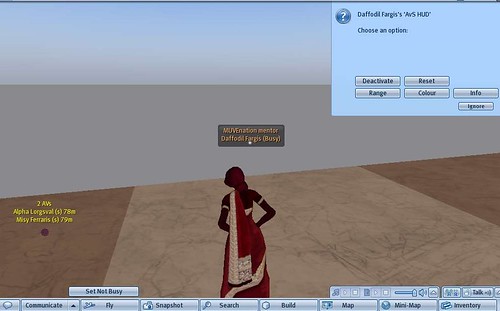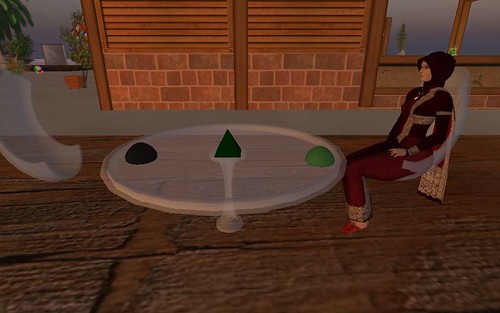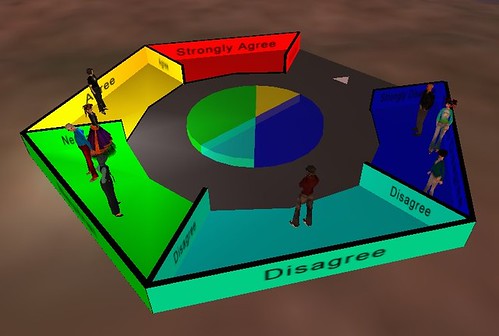What is the task?
Activity 6 of session 3 asks us
- To collect, describe and comment on a number of tools that are suitable for teaching and learning in Second Life based upon a chosen theme
- To design an experience-based, interactive and playful activity for a teacher to discover these tools in Second Life, such as creating a tour guide.
The themes are
- Delivery of learning material
- Communication and interaction
- Cooperation
- Creation of content
- Individualisation of learning paths
- Assessment, feedback and tracking
- Self-organisation and group-organisation
- Reflection and meta cognition
I decided to join colleagues to collaborate on finding tools (in the broadest sense) that help teachers to manage social interaction and communication with their learners. As I mentioned in a previous post, effective communication can be a challenge in SL for many reasons but is very important and can decide about the success or failure of a session or even a course.
Which tools are essential?
There are tens of communication tools and facilities in SL. We have selected only a few for this activity. The three I added to the book are the following:
1. Avatar Scanner (also often referred to as “chat range alarm”): Many avatars are not aware that what they say can only be heard within a certain distance and even if they know it is difficult to judge when one is outside the range. This can lead to communication breakdown and misunderstandings. An teacher or participant of a meeting might wonder why nobody or not all are following the conversation or instructions not realising that they are out of chat range. One solution that has been suggested to me in the comments of another post is using a kind of visual circle but that is limited to one place. This is good when the teacher or moderator wants to create spaces for group work or discussion. Another solution is a HUD that avatars can wear and take with them where ever they go. This Avatar Scanner HUD is user friendly, small and available for free.

2. Another very common issue in meetings with a lot of avatars is the flow of conversation. Often many conversation threads and topics are interwoven and it becomes difficult to follow the conversation. Therefore, in some instances the moderator might want to control the stream of conversation. There are several tools available but some are too rigid and others too expensive. The Meeting control lights tool gives more control to both the moderator and the speakers and is more transparent (e. g. everybody can see whose next).

3. Static lessons are not good in Real Life but even less suitable for SL. With the Opinionator, lessons and meetings can be much more interactive and fun. Instead of simply replying in text or voice to discussion questions, participants can use the Opinionator, which is a 3D Likert Scale social graphing tool that collates votes. When a question is asked, avatars walk into the different sections of the opinionator to show their vote or opinion. The total number of avatars and the percentage is calculated and shown immediately. Great before or after discussions. Very interactive and good for visual and kinaesthetic learners.

The rest of our list is here (work in progress). If you think we missed a good tool, especially if it is a free or reasonably-priced one, let me know.
How will we present them?


We discussed two options to present our tools, a tour HUD or a book. Personally, I did not like the free tour HUDs that were available. The text field and the font itself was too small and I have tools which are not available in an in-world shop but only online and the HUDs we have do not provide URLs.
I finally found a book that can also be worn as a HUD. I provided the Slurls and URLs in shortened form and we added a notecard with the Landmarks and a notecard giver script to the book.
What can go wrong?
The problem with such a HUD tour and even the book is that tools, shops or other educational places and facilities can be moved to other locations or disappear completely. Only recently, one of the participants in our group has created a tour which includes Boracay, an educational island. However, two days later, the island was dismantled and will soon cease to exist completely after having been there for over two years. This is probably something we have to get used to although it is very sad to see such work disappear. Some tour or guide objects that provide lists of educational places take this into account and update their lists regularly. One such tool is the free Squirrel notebook which is available for free here.
Where?
Here is the Slurl to the location where you can get a copy of our book and the tool collections of the other groups are nearby, too. The exhibition is only temporary so visit it soon.
I gather that part of Boracay will probably be used in an online course beginning in January. Sadly, Boracay has gone, a reminder that such islands cost significant money in rent, but creators presumably keep a copy and future reappearance is technically possible.
Pingback: Teaching in Second Life » Blog Archive » Summary of my SLTalk presentation